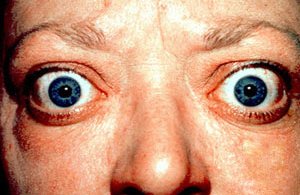Graves' eye Disease is an eye condition that affects up to half of those living with Graves' disease, an autoimmune disease that causes hyperthyroidism.
The thyroid is a butterfly-shaped gland in the front of the neck that secretes hormones essential to the body. Those hormones help regulate the way the body uses energy, produces heat and consumes oxygen.
MORE HEALTH: Nearly 1 in 4 young adults have 'smartphone addiction,' study says
But in people with Graves' disease, the thyroid produces too many hormones, which can cause inflammation in the muscle and tissue around the eyes.
Graves' disease affects about one in every 200 people, CNN reports, and there are approximately 1 million new people diagnosed with Graves' eye disease a year. Those at greatest risk are middle-aged adults, particularly women and smokers. People who have hyperthyroidism, but not Graves' disease, also can have their eyes affected.
Bulging eyes are the most common symptom of Graves' eye disease, also known as Graves' opthalmopathy. Other symptoms include irritation in the eyes, excessive tearing, eye pain, dry eye, redness in the white part of the eye or swelling of the eyelids.
In most cases, the symptoms either will improve within a couple of years or at least never worsen. However, about 3-5% of people with Graves' eye disease will develop more serious symptoms such as intense pain and corneal ulcerations – sores on the cornea that can lead to vision loss and blindness if not treated.
It is especially important that people with Graves' disease or hyperthyroidism receive regular eye exams. Anyone experiencing symptoms of Graves' eye disease who have not been diagnosed with thyroid disease should make an appointment with an eye doctor as soon as possible.
Graves' eye disease can be diagnosed by a physical examination or with a computed tomography (CT) or magnetic resonance imaging (MRI) scan.
There is no real way to prevent Graves' eye disease. And radioiodine therapy to treat hyperthyroidism can actually increase the risk, according to the American Thyroid Association. Some evidence suggests that taking a corticosteroid drug at the time of the radioiodine therapy may lessen that risk.
Treatment includes cool compresses on the eyes, wearing sunglasses and using eye drops. Elevating the head of the bed may also help to reduce the swelling and pressure on the eyes.
A doctor also may prescribe steriods or recommend surgery on either the eyelid or eye muscle. For more serious cases where people are at risk of going blind, a doctor may perform orbital decompression surgery in which the bone between the eye socket and sinuses is removed.
Harvard Health experts also emphasize that people with Graves' eye disease need to be treating their overactive thyroids as well.
"After treatment of overactive thyroid, there is a substantial risk of becoming hypothyroid (an underactive gland)," they wrote. "Thyroid replacement is essential to help keep Graves' eye disease from getting worse."


